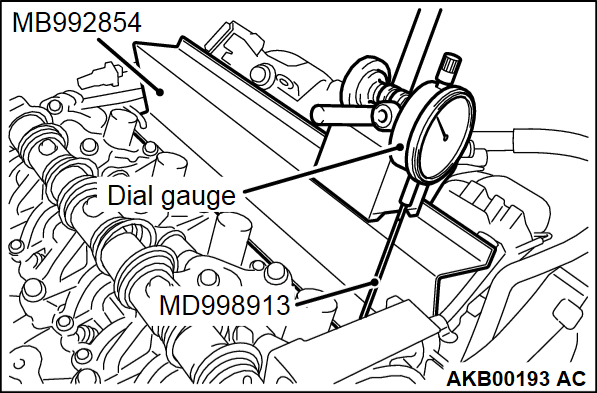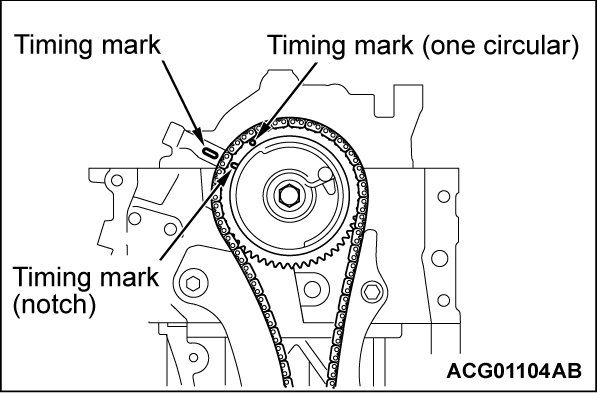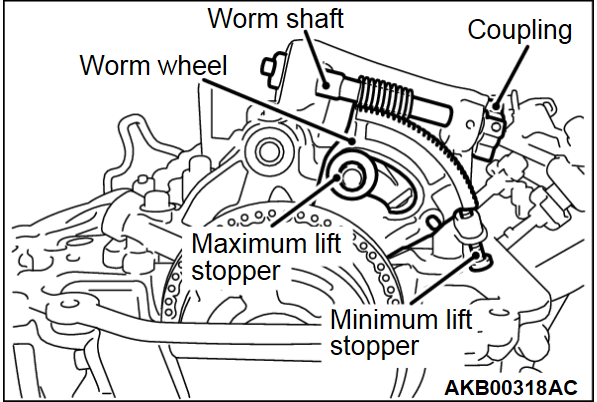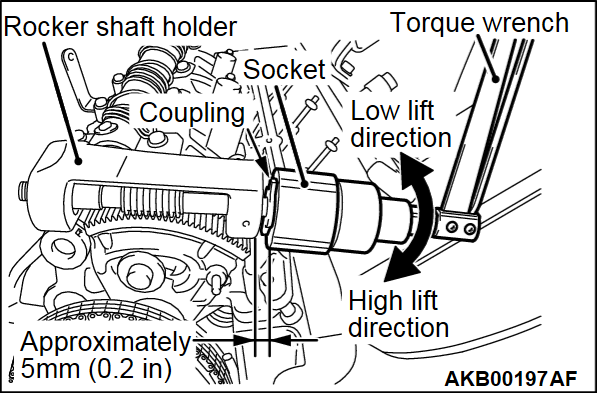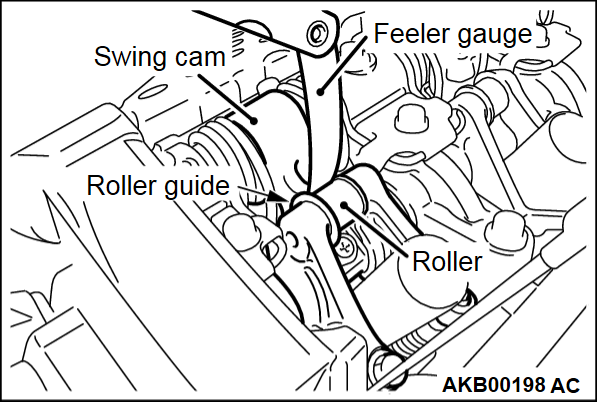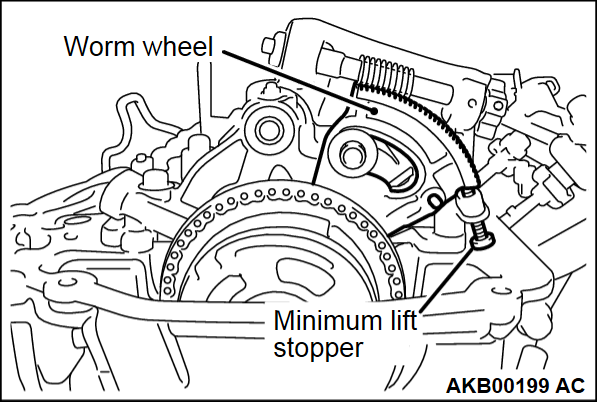INSPECTION
VALVE CLEARANCE ADJUSTMENT
| note | The inlet valve side has the inlet continuous variable valve lift system. The oil clearance between the arm and the shaft makes it difficult to measure the valve clearance with the usual feeler gauge. Therefore, use the dial gauge and check the amount of valve lift. |
1. Install the special tool magnet base plate (MB992854) to the upper face of the cylinder head at the inlet side.
2. Install the special tool dial gauge extension (MD998913) to the dial gauge.
3. When installing the dial gauge to the magnet base plate, the dial gauge must have almost the same angle as the inlet valve has.
4. Rotate the crankshaft clockwise and align the timing mark of the rocker shaft holder with the timing mark (notch) of the V.V.T. sprocket. Therefore, the No. 1 cylinder is set at the top dead center on its compression stroke.
5. For the No. 1 cylinder inlet valve, adjust the valve clearance according to the following procedures.
6.
Slowly rotate the coupling clockwise. When lightly touching the worm wheel to the minimum lift stopper, stop the worm wheel at the position shown in the illustration.
| caution |
|
| note | When rotating the coupling clockwise, the worm wheel should move in the minimum lift direction. When rotating the coupling counterclockwise, the worm wheel should move in the maximum lift direction. |
| note | When manually rotating the coupling, insert a 12-point socket (24 mm) into the position on the coupling approximately 5 mm (0.2 inch) away from the rocker shaft holder. Connect the mini torque wrench and slowly rotate them. |
7. Set the dial gauge on the upper face of the valve spring retainer at the forward engine side. Set the dial gauge to 0.
| note | As shown in the illustration, prevent the measurement error caused by the tilted valve, install the rocker arm to the outside of the rocker arm. |
8.
Between the swing cam and the roller of the rocker arm, insert the feeler gauge with 0.15 mm (0.006 inch) thickness, to approximately 5 mm (0.2 inch) from the top. Manually holding it, perform the adjustments according to the following procedures.
| caution |
|
9.
Check the worm wheel stopping at the position as shown in the illustration, lightly touching to the minimum lift stopper. At that time, manually hold the thickness gauge so that the thickness gauge cannot excessively be inserted.
| caution | Do not forcibly push the worm wheel to the minimum lift stopper. |
10. Loosen the rocker arm lock nut at the forward engine side. Pull up the adjusting screw once. From the upper portion of the adjusting screw, sufficiently apply the engine oil between the lower adjusting screw end and the valve axis end so that the engine oil can be provided enough. And then, perform the adjustment by rotating the adjusting screw so that the dial gauge can read -0.11 mm(-0.004 inch).
11. For the valve at the backward engine side, check the valve clearance in the same procedure as that of the valve at the forward engine side. If the valve clearance is not within the standard value, perform the adjustment in the same procedure as that of the valve at the forward engine side.
12. After the adjustment, hold the driver to prevent the adjustment screw from rotating. Tighten the lock nut to the specified torque. And then, check that the dial gauge reading does not change.
Tightening torque: 9.0 ± 1.0 N·m (80 ± 8 in-lb)
13. Check again the valve clearance at the forward engine side. If the valve clearance is not within the standard value, perform the adjustment in the same procedure as the first adjustment.
14. After the adjustment, hold the adjusting screw by the driver not to rotate the adjusting screw. Temporarily tighten the lock nut. Rotate the coupling counterclockwise and return the worm wheel to the middle lift position. Pull out the thickness gauge.
Specified torque: 9.0 ± 1.0 N·m (80 ± 8 in-lb)
15. For the No. 2 cylinder inlet valve, adjust the valve clearance according to the procedures from Step 7 to Step 14.
16. For the No. 1 and No.3 cylinder exhaust valves, adjust the valve clearance according to the following procedures.
17. Insert the feeler gauge between the exhaust valve axis end and the adjusting screw. Loosen the lock nut. Adjust the valve clearance so that the clearance is within the standard value by rotating the adjusting screw.
Standard value: 0.20 ± 0.03 mm (0.008 ± 0.001 inch)
18. After the adjustment, hold the driver to prevent the adjustment screw from rotating. Tighten the lock nut to the specified torque.
Tightening torque: 9.0 ± 1.0 N·m (80 ± 8 in-lb)
19. Rotate the crankshaft clockwise 1 revolution. Therefore, the No. 4 cylinder is set at the top dead center on its compression stroke.
20. For the No. 3 cylinder inlet valve, adjust the valve clearance according to the procedures from Step 7 to Step 14.
21. For the No. 4 cylinder inlet valve, adjust the valve clearance according to the procedures from Step 7 to Step 14.
22. For the No. 2 and No. 4 cylinder exhaust valves, adjust the valve clearance according to the procedures from Step 17 to Step 18.
![[Previous]](../../../buttons/fprev.png)
![[Next]](../../../buttons/fnext.png)
